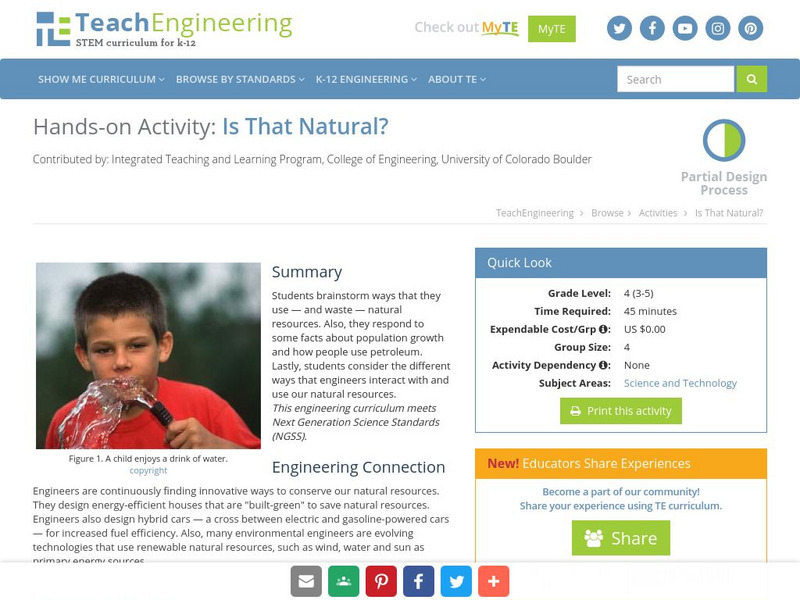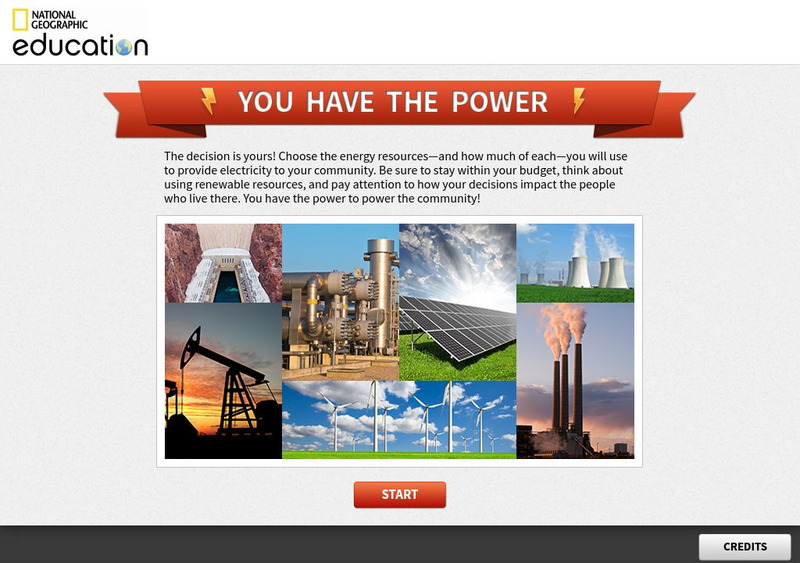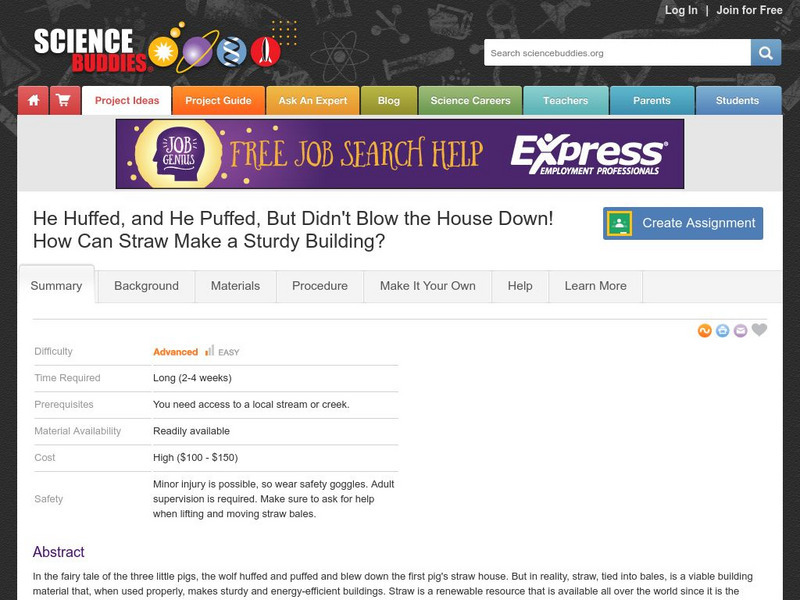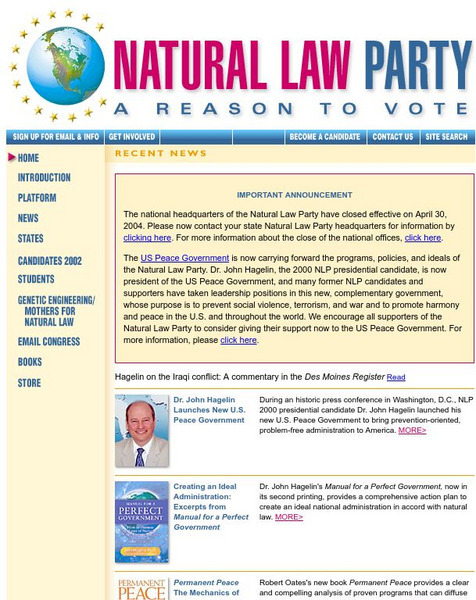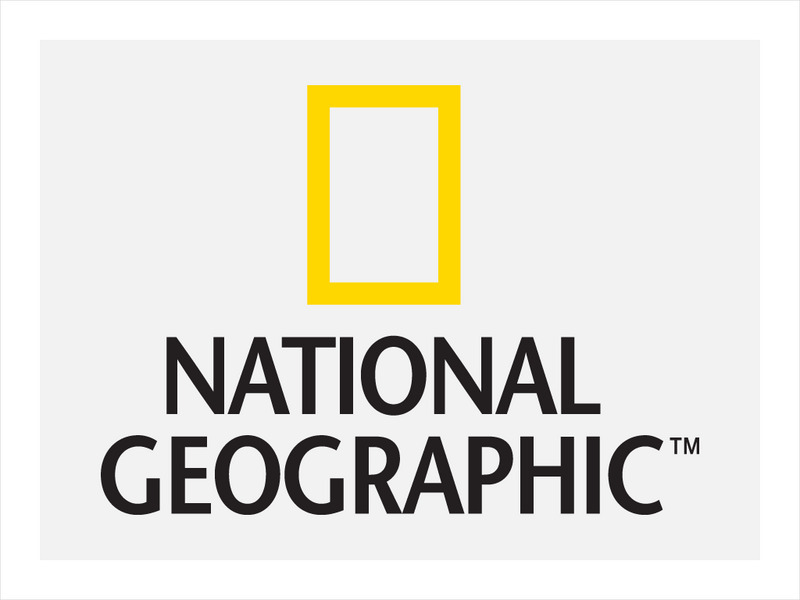Hi, what do you want to do?
PBS
Pbs Learning Media: Deciding Your City's Energy Future
Students learn about fossil fuels and renewable energy sources to help them decide which type of energy should be used to power a city's electric grid in the coming decades.
Other
Institute for Energy Research: Fossil Fuels
A detailed article providing information about fossil fuel resources in the United States and how they impact economic growth. Several reports, which can be downloaded, examine energy policies, the potential for economic growth, and...
TeachEngineering
Teach Engineering: The Great Divide
In this activity, students will use cookies to simulate the distribution of our nonrenewable resources (energy). Then, they will discuss how the world's growing population affects the fairness and effectiveness of this distribution of...
TeachEngineering
Teach Engineering: Naturally Speaking
In this lesson, learners will identify the Earth's natural resources and classify them as renewable or non-renewable. They will simulate the distribution of resources and discuss the fairness and effectiveness of the distribution....
TeachEngineering
Teach Engineering: Is That Natural?
Students will brainstorm ways that they use - and waste - natural resources. Also, they will respond to some facts about population growth and how people use petroleum. Lastly, students will consider the different ways that engineers...
Other
Wisconsin K 12 Energy Education Program (Keep)
The mission of KEEP is to improve energy education in Wisconsin's schools. It provides teachers access to resources, activities and web support for many hands-on lessons for all grade levels.
TeachEngineering
Teach Engineering: Introduction to Environmental Engineering
Students are presented with examples of the types of problems that environmental engineers solve, specifically focusing on air and land quality issues. Air quality topics include air pollution sources, results of poor air quality...
National Geographic
National Geographic: You Have the Power
What factors are important to consider in order to make informed energy decisions? In this interactive, you select one of three locations and the energy resources and then try to provide 100% of that community's electricity needs while...
Science Buddies
Science Buddies: He Huffed, and He Puffed, but Didn't Blow the House Down!
In the fairy tale of the three little pigs, the wolf huffed and puffed and blew down the first pig's straw house. But in reality, straw tied into bales is a viable building material that when used properly, makes sturdy and...
Other
Flasolar: Solar Energy
An overview of practical uses of solar energy. Information and basic facts about solar energy use in homes and businesses. Covers the history, economics, and ecology of solar energy and includes pictures and schematics of solar technology.
US Energy Information Administration
U.s. Eia Energy Kids: Renewable Energy: Wind
Mankind has used the wind as an energy source for thousands of years. Discover other ways the wind is used to make energy.
US Energy Information Administration
U.s. Eia Energy Kids: Nonrenewable Energy Sources
This resource provides information about nonrenewable energy sources. There is specific information about each of these energy sources, and lots of maps, charts, tables, and graphs to further the understanding.
National Academies of Sciences, Engineering, and Medicine
The National Academies: Our Energy Sources
The many sources of energy production in the United States are described in this overview. Included are traditional sources, renewable sources, and new energy production technologies.
State Energy Conservation Office-Texas
State Energy Conservation Office: Energy Sources: Fuels From Biomass: Biodiesel
Discusses biodiesel fuel production and the benefits that this renewable energy resource has for the environment and the economy.
PBS
Pbs Learning Media: Boston Public Schools Capstone Project
The (Boston Public Schools) Capstone Project is an opportunity for students to engage in rigorous project-based learning. It is an opportunity for our students to develop skills to be life, career, and college-ready in a culturally...
American Geosciences Institute
American Geosciences Institute: Energy
Seven hands-on lessons module where students learn about energy. These inquiry-based explorations investigate where energy resources come from and how they are converted into electricity, how fossil fuels form, the importance of...
Other
The Natural Law Party of the United States of America
The homepage of the Natural Law Party of the United States provides its platform, relevant news, and many informational resources.
National Geographic
National Geographic: Energy Solutions: Tapping Into Topography of Lake Turkana
In this lesson, students read and analyze articles about the alkaline water in Lake Turkana in Kenya, and about a wind energy project near Lake Turkana. They then examine the many factors that must be considered when undertaking this...
US Department of Energy
U.s. Department of Energy: Energy Savers
Find information on everything from buying energy-efficient products to using the proper landscaping for particular climates to conserve resources. Starting with an energy assessment, this website will help users reduce their consumption...
Other
My Jewish Learning: Rosh Hashanah
A comprehensive resource about Rosh Hashanah sponsored by Hillel, the foundation for Jewish student life at universities around the world. Learn about the themes explored in Rosh Hashanah liturgies, the origins of the holiday, foods that...
State Energy Conservation Office-Texas
State Energy Conservation Office:energy Sources: Biomass Energy From Agriculture
Texas has the potential for becoming a leading provider of biomass energy due to its agricultural industry. Some crops produced in Texas, such as canola, switchgrass, sorghum, and sugarcane, have been identified as energy crops that...
Other
Ucs: How Hydrokinetic Energy Works
Description of how hydrokinetic power works including resource, conversion, and environmental issues.
TeachEngineering
Teach Engineering: Environment
Through 10 lessons and more than 20 hands-on activities, students are introduced to the concept of an environment and the many interactions within it. As they learn about natural and human-made environments, as well as renewable and...
Other
Lehigh University: Energy
An inquiry-based science unit for middle school young scholars centered on the world's energy sources. The lessons integrate technology and lab activities while teaching about energy sources, production, and consumption.
Other popular searches
- Non Renewable Resources
- Non Renewable Resources
- Science Renewable Resources
- Grade 7 Renewable Resources
- Renewable Resources Wood
- Cookies Renewable Resources
- Renewable Resources Lab
- Ecology Renewable Resources
- Renewable Resources Lessons
- Renewable Resources Worksheets








